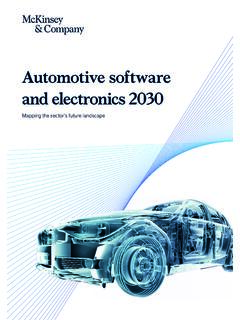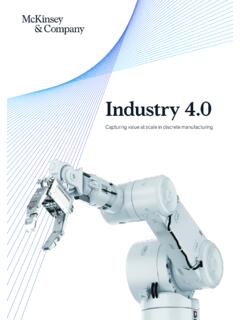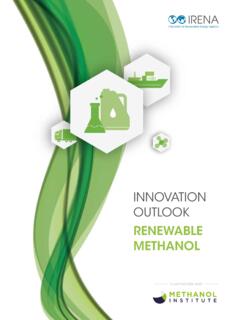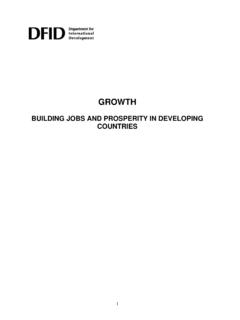Transcription of Decarbonization of industrial sectors: the next frontier
1 June 2018 Decarbonization of industrial sectors: the next frontierAuthored by:Arnout de PeeDickon PinnerOcco RoelofsenKen SomersEveline SpeelmanMaaike WitteveenJune 2018 Decarbonization of industrial sectors: the next frontier2 The industrial sector is a vital source of wealth, prosperity , and social value on a global scale. industrial companies produce about one-quarter of global GDP and employment, and make materials and goods that are integral to our daily lives, such as fertilizer to feed the growing global population, steel and plastics for the cars we drive, and cement for the buildings we live and work also emits about 28 percent of global greenhouse gas (GHG) emissions, of which 90 percent are carbon dioxide (CO2) emissions.
2 Between 1990 and 2014, GHG emissions from major sectors such as buildings, power, and transport increased by 23 percent ( percent per year), while emissions from the industrial sector increased by 69 percent ( percent per year). Over the last decades, the outlines of energy transition pathways have emerged in the buildings, power and transport sectors. These have been driven by technological breakthroughs and cost reduction. For industrial processes, such pathways are less well-defined. The energy transition in industry should be viewed in the context of global trends that will impact the demand for and preferred production routes of industrial products.
3 There is an expected growth in resource demand, driven by an increase in middle class consumers of ~3 billion in the coming 20 years, as well as rapid urbanization. This coincides with growing constraints on key resources, such as copper and zinc, and environmental degradation, for instance from air pollution. On top of that, there are technological breakthroughs. Rapid cost reduction in renewable power generation is driving further electrification. New digital technologies are improving productivity. In the light of these demographic, resource, and technological developments, industrial players should reconsider their strategies.
4 This report provides a global perspective on the energy transition in industry, with a focus on reducing CO2 emissions from industrial processes in cement, steel, ammonia, and ethylene production. It shows that Decarbonization of industry is technically possible through a combination of technical solutions, the optimum mix of which will vary widely between sectors and regions. It also shows that in many cases decarbonized production processes are currently not cost competitive with conventional production technology. In cases such as these, where there is currently an absence of an economic driver, Decarbonization would require technological breakthroughs, a further lowering of zero-carbon energy prices, changing customer preferences (willingness to pay) and/or a regulatory push.
5 This should not be seen as a ground to delay action. We believe that starting now with the Decarbonization of industry would lead to better outcomes for individual companies. The long time horizons involved in building or retrofitting industrial sites mean that significant emission reductions can be achieved more efficiently through investment and plans initiated now, with an eye on capitalizing on future of industrial sectors: the next frontier3 This report offers industrial executives, policy makers, and others a menu of options for Decarbonization , along with ideas for how to prioritize and pursue them.
6 We describe the industrial sector s role in the climate challenge and explain how a range of innovative technologies and processes could cut CO2 emissions from the production of four major industrial commodities: cement, steel, ethylene, and ammonia. We present our analyses of how companies in the four focus sectors might assemble portfolios of Decarbonization options that reflect their growth strategies and local conditions near their production sites. Based on these outcomes, we assess the ( industrial ) investments and changes to the energy system that are required to decarbonize these industrial processes.
7 The report concludes with recommendations for how executives and policy makers can position themselves as industrial Decarbonization progresses. The findings in this report would not have been possible without the valuable input of many industry and energy experts. We are especially grateful to the leaders and members of the Energy Transitions Commission for sharing their views with us, and to Cedric Philibert (IEA), Marco Mensink (Cefic) and Andy Read (Uniper) for sharing their insights. We would also like to thank Energy Insights, McKinsey s global energy market intelligence and analytics group, and a number of colleagues for their support and insights: Peter Berg, Nicolas Denis, Dirk Durinck, Michel van Hoey, Maria Kolobova, Nathan Lash, Timo Leenman, Carlos Mendes, Joris van Niel, and Theo Jan Simons.
8 The findings presented here represent our own, independent perspective. We share them in the hope of informing public discussion about the Decarbonization challenge and helping industrial companies develop effective approaches to decarbonizing their de Pee, Dickon Pinner, Occo Roelofsen, Ken Somers, Eveline Speelman, and Maaike WitteveenDecarbonization of industrial sectors: the next frontier45 ContentsExecutive summary 6 1. Industry s role in the climate challenge 12 The industrial sector is both a global economic powerhouse and a major emitter of GHG emissions 2. The next frontier 20 After breakthroughs in power, transport, and buildings sectors, industrial Decarbonization is the next frontier 3.
9 Options for decarbonizing industry 24 industrial companies can reduce CO2 emissions in various ways, with the optimum local mix depending on the availability of biomass, carbon-storage capacity and low-cost zero-carbon electricity and hydrogen, as well as projection changes in production capacity 4. Application of Decarbonization options in the four focus sectors 36 Each of the industrial processes in the focus sectors requires a tailored set of options and innovations for Decarbonization 5. The investment and energy requirements for industrial 48 Decarbonization industrial Decarbonization will require increased investment in industrial sites and has to go hand in hand with an accelerated build-out of zero-carbon electricity generation 6.
10 Charting a way forward 54 Advance planning and timely action could drive technological maturation, lower the cost of industrial Decarbonization and ensure the industry energy transition advances in parallel with required changes in energy supply Technical appendix 586 Decarbonization of industrial sectors: the next frontierIn the Paris Agreement of 2015, member states agreed to limit global warming to 2 C versus pre- industrial levels. This would imply reducing greenhouse gas (GHG) emissions by 80 to 95 percent of the 1990 level by 2050. As industry accounted for about 28 percent of global greenhouse gas emissions in 2014, it follows that these targets cannot be reached without decarbonizing industrial activities.














